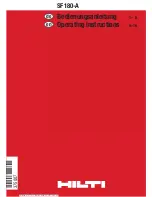
6
Do not use dull or damaged blade.
Unsharpened or improperly set blades pro-
duce narrow kerf causing excessive friction,
blade binding and KICKBACK. Keep blade
sharp and clean. Gum and wood pitch hard-
ened on blades slows saw and increases
potential for kickback. Keep blade clean by
first removing it from tool, then cleaning it
with gum and pitch remover, hot water or ker-
osene. Never use gasoline.
Blade depth and bevel adjusting locking
levers must be tight and secure before
making cut.
If blade adjustment shifts while
cutting, it will cause binding and KICKBACK.
Use extra caution when making a “Pocket
Cut” into existing walls or other blind
areas.
The protruding blade may cut objects
that can cause KICKBACK. For pocket cuts,
retract lower guard using Retracting Lever.
ALWAYS hold the tool firmly with both
hands. NEVER place your hand or fingers
behind the saw.
If kickback occurs, the saw
could easily jump backwards over your hand,
leading to serious personal injury.
Never force the saw. Forcing the saw can
cause uneven cuts, loss of accuracy, and
possible kickback.
Push the saw forward at a speed so that the
blade cuts without slowing.
12. Be aware that this tool is always in an
operating condition, because it does not
have to be plugged into an electrical out-
let.
13. Use extra caution when cutting damp
wood, pressure treated lumber, or wood
containing knots.
Adjust speed of cut to
maintain smooth advancement of tool without
decrease in blade speed.
14. Adjustments. Before cutting be sure
depth and bevel adjustments are tight.
15. Avoid Cutting Nails. Inspect for and
remove all nails from lumber before cut-
ting.
16. The tool is provided with a front grip
(motor housing) and rear handle for two
hand operation. Operate with proper hand
support and proper workpiece support.
WARNING: It is important to support the
workpiece properly and to hold the saw
firmly to prevent loss of control which
could cause personal injury. Fig. 4 illus-
trates typical hand support of the saw.
17. Place the wider portion of the saw base on
that part of the workpiece which is solidly
supported, not on the section that will fall
off when the cut is made. As examples,
Fig. 5 illustrates the RIGHT way to cut off
the end of a board, and Fig. 6 the WRONG
way. If the workpiece is short or small,
Fig. 2
Do not support board or panel away from
the cut.
Fig. 3
Fig. 4
A typical illustration of proper hand sup-
port and workpiece support.
Summary of Contents for 5090D
Page 15: ...Memo 15 ...
Page 16: ...Memo 16 ...






































